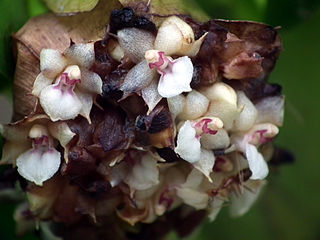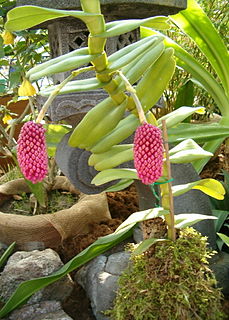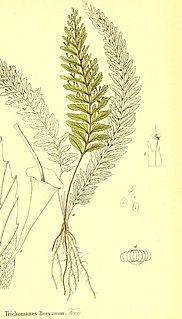
Agrostophyllum is a genus with about ninety species from the orchid family (Orchidaceae). The genus name is derived from the Greek words agrostis ("grass") and phyllos ("leaf"), referring to the grass-like appearance of the leaves of some species.

Canarium is a genus of about 100 species of tropical and subtropical trees, in the family Burseraceae. They grow naturally across tropical Africa, south and southeast Asia, Indochina, Malesia, Australia and western Pacific Islands; including from southern Nigeria east to Madagascar, Mauritius, Sri Lanka and India; from Burma, Malaysia and Thailand through the Malay Peninsula and Vietnam to south China, Taiwan and the Philippines; through Borneo, Indonesia, Timor and New Guinea, through to the Solomon Islands, New Caledonia, Fiji, Samoa, Tonga and Palau.

Claoxylon is a flowering plant genus in the spurge family, Euphorbiaceae, comprising dioecious subshrubs to small trees. It was first described as a genus in 1824. The genus is distributed in paleotropical areas: Madagascar through South and Southeast Asia, Malesia to Melanesia, Hawaiʻi, and Australia. Half of the species are in Malesia. According to a molecular phylogenetic study by Wurdack, Hoffmann & Chase (2005), Claoxylon is sister to Erythrococca, and together they form the top of a Hennigian comb-like phylogeny.

Endospermum is a genus of plants, under the family Euphorbiaceae and the monotypic subtribe Endosperminae first described as a genus in 1861 It is native to E + S + SE Asia, Papuasia, Queensland, and certain islands of the W Pacific.

Barringtonia is a genus of flowering plants in the family Lecythidaceae first described as a genus with this name in 1775. It is native to Africa, southern Asia, Australia, and various islands of the Pacific and Indian Oceans. The genus name commemorates Daines Barrington.

Bikkia is a genus of flowering plants in the family Rubiaceae. It is native to the Philippines, the Maluku region of eastern Indonesia, New Guinea and the western Pacific. The genus was named by Caspar Reinwardt in 1825. Seven of the New Caledonian species previously included in Bikkia were transferred to a separate genus, Thiollierea, in 2011 based on molecular and morphological information.

Melodinus is a genus of plant in the family Apocynaceae, first described as a genus in 1776. It is native to Indomalaya, Meganesia and various islands in the western Pacific. A type of monoterpenoid indole alkaloids called melodinines can be isolated from Melodinus plants.

Ochrosia is a genus of flowering plants, first described in 1789. It is in the family Apocynaceae, native to Southeast Asia, Australia, and various islands of the Indian and Pacific Oceans.
- Ochrosia ackeringae(Teijsm. & Binn.) Miq. – Indonesia, Philippines, Papuasia, Christmas Island
- Ochrosia acuminataTrimen ex Valeton - Sulawesi
- Ochrosia alyxioidesGuillaumin - Vanuatu
- Ochrosia apoensisElmer - Luzon, Mindanao
- Ochrosia balansae(Guillaumin) Baill. ex Guillaumin - New Caledonia
- Ochrosia basistaminaHendrian - Sulawesi
- Ochrosia bodenheimarumGuillaumin - Vallée de la Toutouta in New Caledonia
- Ochrosia borbonicaJ.F.Gmel. – Mauritius + Réunion; naturalized in Guangdong
- Ochrosia brevitubaBoiteau - New Caledonia
- Ochrosia brownii(Fosberg & Sachet) Lorence & Butaud - Nuku Hiva in Marquesas
- Ochrosia citrodoraK.Schum. & Lauterb. - New Guinea
- Ochrosia coccinea(Teijsm. & Binn.) Miq. - Maluku, Sulawesi, New Guinea, Solomon Islands; naturalized in Guangdong
- Ochrosia comptaK.Schum., Hōlei – Hawaii
- Ochrosia ellipticaLabill. – Lord Howe Island, Queensland, New Caledonia, Vanuatu, Nauru; naturalized in Guangdong + Taiwan
- Ochrosia fatuhivensisFosberg & Sachet – Fatu Hiva in Marquesas but extinct
- Ochrosia ficifolia(S.Moore) Markgr. - New Guinea
- Ochrosia glomerata(Blume) F.Muell. - Borneo, Sulawesi, Philippines, Maluku, New Guinea, Solomon Islands
- Ochrosia grandifloraBoit. – New Caledonia
- Ochrosia haleakalaeH.St.John, Hōlei – Maui + island of Hawaiʻi in Hawaiian Islands
- Ochrosia hexandraKoidz. - Kazan-retto
- Ochrosia inventorumL.Allorge – New Caledonia
- Ochrosia iwasakiana(Koidz.) Koidz. ex Masam.
- Ochrosia kauaiensisH.St.John, Hōlei – Kauaʻi in Hawaiian Islands
- †Ochrosia kilaueaensisH.St.John, Hōlei – island of Hawaiʻi in Hawaiian Islands, but extinct
- Ochrosia kilneriF.Muell. - Queensland
- Ochrosia lifuanaGuillaumin - Loyalty Islands + Isle of Pines in New Caledonia
- Ochrosia mariannensisA.DC. - Mariana Islands
- Ochrosia mianaBaill. ex Guillaumin – New Caledonia
- Ochrosia minima(Markgr.) Fosberg & Boiteau – Queensland, Papua New Guinea
- Ochrosia moorei(F.Muell.) F.Muell. ex Benth. – Queensland, New South Wales
- Ochrosia mulsantiiMontrouz. – New Caledonia
- Ochrosia nakaiana(Koidz.) Koidz. ex H.Hara - Ogasawara-shoto
- Ochrosia newellianaF.M.Bailey – Queensland
- Ochrosia novocaledonicaDäniker – New Caledonia
- Ochrosia oppositifolia(Lam.) K.Schum. - Seychelles, Chagos Islands, Sri Lanka, Maldive Islands, Andaman & Nicobar Islands, Thailand, Vietnam, W Malaysia, Indonesia, Papuasia, Samoa, Tonga, Tuvalu, Vanuatu, Wallis & Futuna, French Polynesia, Line Islands, Micronesia
- Ochrosia poweriF.M.Bailey - Queensland, New South Wales
- Ochrosia sciadophyllaMarkgr - Bismarck Archipelago, Solomon Islands
- Ochrosia sevenetiiBoiteau - New Guinea
- Ochrosia silvaticaDäniker – New Caledonia
- Ochrosia solomonensis(Merr. & L.M.Perry) Fosberg & Boiteau - Solomon Islands
- Ochrosia syncarpaMarkgr. - Bali, Lombok, Timor, Flores
- Ochrosia tahitensisLaness. ex Pichon – Tahiti
- Ochrosia tenimberensisMarkgr. - Tanimbar Islands
- Ochrosia nukuhivensisFosberg & Sachet = Rauvolfia nukuhivensis(Fosberg & Sachet) Lorence & Butaud
- Ochrosia sandwicensisA.DC. = Rauvolfia sandwicensisA.DC.
- Ochrosia tuberculata(Vahl) Pichon = Rauvolfia sandwicensisA.DC.

Robiquetia, commonly known as pouched orchids, or 寄树兰属 , is a genus of flowering plants from the orchid family, Orchidaceae. Plants in this genus are epiphytes with long, sometimes branched, fibrous stems, leathery leaves in two ranks and large numbers of small, densely crowded flowers on a pendulous flowering stem. There are about eighty species found from tropical and subtropical Asia to the Western Pacific.
The Oceania Swimming Association is the continental governing body recognised by FINA, for the national governing bodies of swimming, open water swimming, diving, water polo, synchronised swimming and masters swimming in Oceania.

Cyrtosperma is a genus of flowering plants in the family Araceae. The genus went through considerable taxonomic changes in the 1980s, and as a result is now considered to be native only to Southeast Asia and some Pacific islands. Previously, the genus was believed to be widespread from Asia to Africa and South America, but the African and South American species were subsequently moved into separate genera. Cyrtosperma is now known to be most prominent in New Guinea. The genus Cyrtosperma is unique in this regards because it is the only known big genus in Araceae that is known to be found east of Wallace's line.

Atractocarpus is a genus of flowering plants in the family Rubiaceae. Its members are commonly known as native gardenias in Australia. The genus name is derived from the Ancient Greek terms atractos "spindle", and karpos "fruit", from the spindle-shaped fruit of the type species.

Adina is a genus of 11 species of flowering plants in the family Rubiaceae. They are shrubs or small trees, native to East Asia and Southeast Asia.

Neonauclea is a genus of flowering plants in the family Rubiaceae. It comprises about 71 species. Neonauclea is a genus of shrubs and trees They are indigenous to China, India, Southeast Asia, Wallacea, New Guinea and Australia.
Amaracarpus is a genus of shrubs, treelets or trees in the family Rubiaceae. It was described by Carl Ludwig Blume in 1826. Most of the species are endemic to New Guinea but a few have wider ranges in Southeast Asia from Myanmar (Burma) and the Andaman Islands across Thailand, Malaysia, Indonesia, the Philippines, Melanesia, Christmas Island, Queensland and Vanuatu. One species also occurs in the Seychelles. Several species were published years ago but are today not represented by any type specimens or other known existing material.

Benkara is a genus of flowering plants in the family Rubiaceae. It is found in tropical and subtropical Asia from India east to China and the Ryukyu Islands, south to Java and the Philippines. It was described by Michel Adanson in 1763.
Calycosia is a genus of flowering plants in the family Rubiaceae. It was described by Asa Gray in 1860. The genus is found in New Guinea, the Solomon Islands, Fiji, Samoa, and the Society Islands.
Dolicholobium is a genus of flowering plants in the family Rubiaceae. The genus is found from central Malesia to the southwestern Pacific.

Decaspermum is a genus of the botanical family Myrtaceae, first described as a genus in 1776. It is native to China, Southeast Asia, Queensland, and various islands of the Pacific Ocean.

Cephalomanes atrovirens is a species of fern in the family Hymenophyllaceae. The genus Cephalomanes is accepted in the Pteridophyte Phylogeny Group classification of 2016, but not by some other sources. As of October 2019, Plants of the World Online sank the genus into a broadly defined Trichomanes, while treating the subtaxa of this species as the separate species Trichomanes acrosorum, Trichomanes atrovirens, Trichomanes boryanum and Trichomanes kingii.















